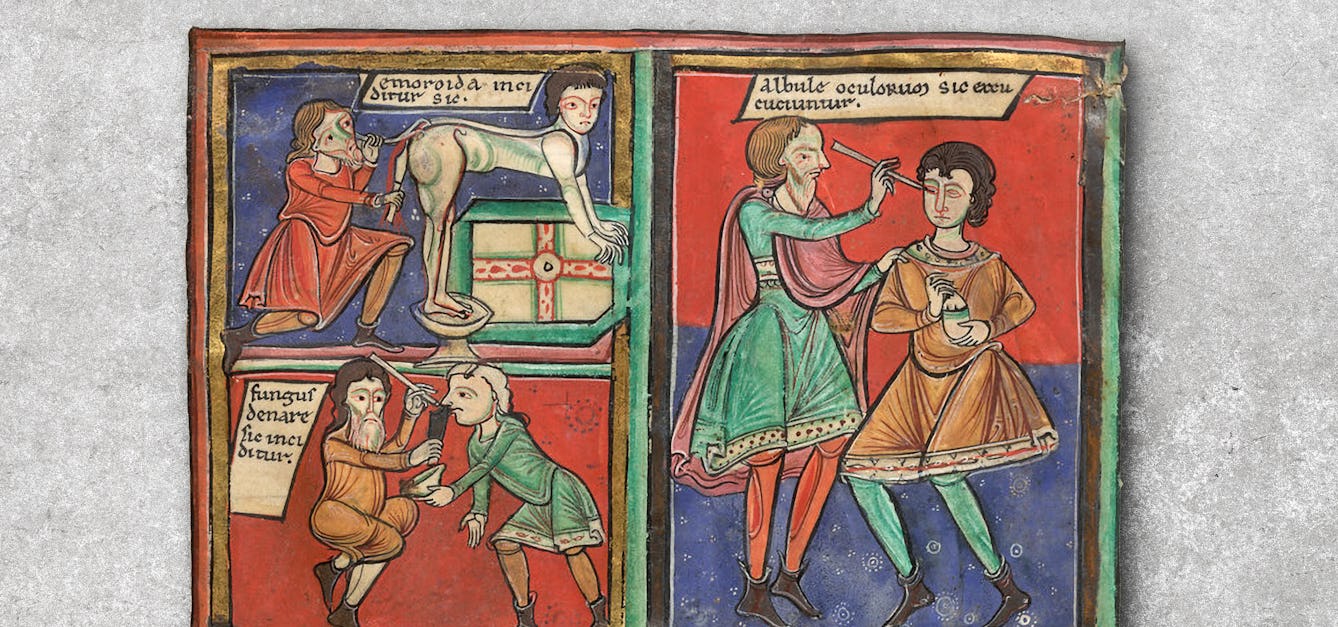Stories

- Article
NHS Blue: the colour of universal healthcare
The 1980s and 1990s saw ideas from the world of business infiltrating the NHS, including the introduction of an internal market, followed by a corporate branding exercise.

- Article
Revelations of blindness in the Middle Ages
Medieval texts, from Islamic medical treatises to Christian books of miracles, reveal surprisingly varied and complex experiences of blindness. But when medieval scholar Jude Seal experienced visual impairment themselves, they gained an even deeper understanding of the lives they were studying.

- Article
Fees, funding and the NHS
In the 1950s, dramatic political battles over NHS charges brought down a government. But public confidence in the service still grew.

- Article
The making of ‘Quacks’
How do you create a medical comedy that’s authentic and laugh-out-loud funny?
Catalogue

- Books
- Online
The recent progress of obstetric and gynaecological medicine : an address delivered in the Obstetrical Section of the Academy of Medicine in Ireland / by Thomas More Madden.
Date: 1886
- Books
- Online
Finality in surgery : an address delivered in the Surgical Section of the Academy of Medicine in Ireland, at the opening meeting, November 12, 1886 / by Sir William Stokes.
Stokes, Sir William, 1839-1900.Date: 1886- Books
Catalogue of an exhibition of books from Lichfield Cathedral Library on the occasion of a visit by members of The Section of the History of Medicine, The Royal Society of Medicine, 18th June 1994 / [compiled by] Denis Gibbs.
Lichfield Cathedral. Library.Date: 1994
- Books
- Online
Art and epigram regarding science and medicine in relation to death : being a reprint of a communication from the Proceedings of the Royal Society of Medicine (Section of the History of Medicine), 1914, Vol. VII, pp. 192-217 : together with an addition on epigram and art in relation to the excessive fear of death / by F. Parkes Weber.
Weber, Frederick Parkes, 1863-1962.Date: 1914- Books
The Royal College of Physicians of London, on the occasion of its recent bombing / by A.P. Cawadias.
Cawadias, A. P. (Alexander Panagioti), 1884-Date: 1957
![Dactylorhiza aff fuchsii Druce ex Soo Orchidaceae Common Spotted orchid. Distribution: Ireland to Mongolia. Roots look like a hand. Coles (1657) calls them Palma Christi sive [or] Satyrion (to distinguish it from Ricinus communis which he calls Palma Christi sive Ricinus. This plant is probably his Female Satyrion and another Dactylorhiza, probably one of the English Marsh orchids, is his Male Satyrion Royal, with purple flowers. In common with Orchis he writes 'The full and plump roots of the Satyrium or Orchis, whereof the Electuary Diasatyrium is made, are of mighty efficacy to provoke to venery, which they that have bulbous roots [meaning the testicle shaped roots of Orchis] do by Signature.'. Terrestrial orchids continue, to be harvested by the millions annually in the Middle East for the production of Salep, including Salep ice cream, because of their mythological aphrodisiacal property. Photographed in the Medicinal Garden of the Royal College of Physicians, London.](https://iiif.wellcomecollection.org/image/B0008988/full/282%2C/0/default.jpg)

![Cichorium intybus L., Asteraceae. Chicory, succory. Distribution: Uses: 'Cichory, (or Succory as the vulgar call it) cools and strengthens the liver: so doth Endive' (Culpeper, 1650). The Cichorium sylvestre, Wilde Succorie, of Gerard (1633) and the leaves cooked into a soup for ill people. Linnaeus (1782) reported it was used for Melancholia, Hypochondria, Hectica [fever], haemorrhage and gout. Root contains 20% inulin, a sweetening agent. Dried, roasted and ground up the roots are used as a coffee substitute, best known as Camp coffee (Chicory and Coffee essence). This used to be sold in tall square section bottle with a label showing a circa 1885 army tent with a Sikh soldier standing and serving coffee to a seated officer from the Gordon Highlanders. The bottle on the label has now moved on, and since 2006 it shows the same tent but the Sikh and the Scot are now both seated, drinking Camp coffee together. Photographed in the Medicinal Garden of the Royal College of Physicians, London.](https://iiif.wellcomecollection.org/image/B0008967/full/282%2C/0/default.jpg)



![Origanum dictamnus L. Lamiaceae Dittany of Crete, Hop marjoram. Distribution: Crete. Culpeper (1650) writes: ‘... hastens travail [labour] in women, provokes the Terms [menstruation] . See the Leaves.’ Under 'Leaves' he writes: ‘Dictamny, or Dittany of Creet, ... brings away dead children, hastens womens travail, brings away the afterbirth, the very smell of it drives away venomous beasts, so deadly an enemy is it to poison, it’s an admirable remedy against wounds and Gunshot, wounds made with poisoned weapons, draws out splinters, broken bones etc. They say the goats and deers in Creet, being wounded with arrows, eat this herb, which makes the arrows fall out of themselves.' Dioscorides’ Materia Medica (c. 100 AD, trans. Beck, 2005), Pliny the Elder’s Natural History and Theophrastus’s Enquiry into Plants all have this information, as does Vergil’s Aeneid where he recounts how Venus produced it when her son, Aeneas, had received a deadly wound from an arrow, which fell out on its own when the wound was washed with it (Jashemski, 1999). Dioscorides attributes the same property to ‘Tragium’ or ‘Tragion’ which is probably Hypericum hircinum (a St. John’s Wort): ‘Tragium grows in Crete only ... the leaves and the seed and the tear, being laid on with wine doe draw out arrow heads and splinteres and all things fastened within ... They say also that ye wild goats having been shot, and then feeding upon this herb doe cast out ye arrows.’ . It has hairy leaves, in common with many 'vulnaries', and its alleged ability to heal probably has its origin in the ability of platelets to coagulate more easily on the hairs (in the same way that cotton wool is applied to a shaving cut to hasten clotting). Photographed in the Medicinal Garden of the Royal College of Physicians, London.](https://iiif.wellcomecollection.org/image/B0009085/full/282%2C/0/default.jpg)


